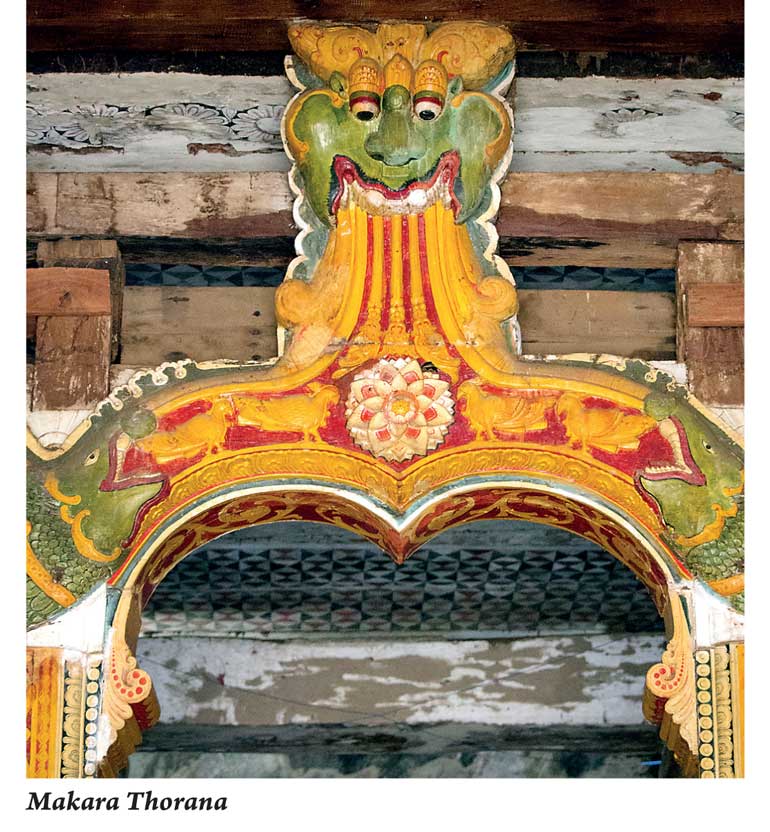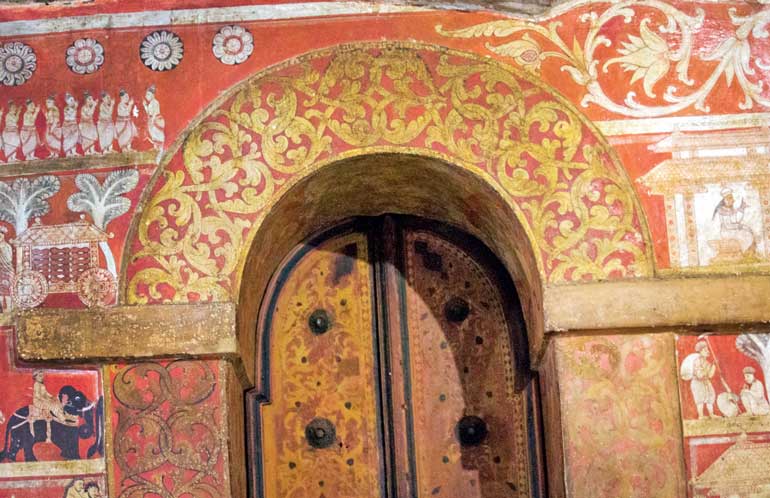Wednesday Nov 26, 2025
Wednesday Nov 26, 2025
Saturday, 7 October 2017 00:56 - - {{hitsCtrl.values.hits}}
 By Aysha Maryam Cassim
By Aysha Maryam Cassim
Throughout the philatelic history of Sri Lanka, many stamps were issued to pay homage to renowned figures, legends and commemorate the anniversaries of significant events.
If you are an ardent stamp collector, you must be familiar with the set of ’70s stamps featuring frescoes of rock temples in Sri Lanka. One of the stamps depicts a scene from ‘Vessantara Jatakaya’ where the king gives his children away as slaves to Jujaka Bamuna who beats them with a cane as he takes them.
This particular stamp which was valued at 35 cents in 1972 happens to be a sequence of a fresco painting housed in Degaldoruwa Temple, Kandy.
The revival of Buddhism and art in the Kandyan Kingdom
Construction of Degaldoruwa Temple commenced under the reign of King Kirthi Sri Rajasinha and was completed under the reign of his brother Rajadhi Rajasinha years later.
During the Kingdom of Kandy (1469–1815) in Sri Lanka, Kings played a prominent role in the revival of Buddhism. They reinstated the higher ordination (Upasampadha) of monks, repainted and restored murals of temples with the support and guidance of Weliwita Saranankara Sangharaja Thero.
Location
Degaldoruwa Temple is located in an idyllic village called Amunugama. From Kandy, it’s only a half an hour drive to this scenic rock cave temple. The temple can be reached via the roadway over Lewella Bridge.
Alternative route from Mawilmada: Proceed along Dutugamanu Mawatha and turn left at the junction towards Sirimalwatte-Yakgahapitya-Menikhinna road.
The Cave Temple
Degamdoruwa temple is hollowed out of a 40-foot rock cave. There is a drummer’s hall, an image house, and shrine room. The stairway on the rock ascends to the ‘Wali Maluwa’ and the Bodiya. The Dagoba on the summit overlooking the mountains of Central Highlands is a sight to behold.
The Moonstone and Dragon Arch
As you enter the temple, there is a magnificent moonstone with distinctive carvings. A lotus is carved in the middle of the triangular stone to indicate the purity of eternity. Surrounding the Nelum Mala is a floral creeper known as Liyawal, symbolising worldly desires called Tanha.
A Makara Thorana (a mythical dragon archway) leads you to the shrine room through an elegant door made from Naa wood. It is believed that once there were gem stones embellished below the golden knobs of the door.
Frescoes of Kandyan era
The finest of Kandyan era frescoes grace the ceilings of Degaldoruwa Temple. Among these paintings are a Maara Parajaya, Sadivya Lokaya (Six Heavens), Suvisi Vivaranaya and Mahee Kanthawa (Earth Goddess) and an image of Buddha with a Bhumisparsha Mudra, commonly known as the ‘earth witness’ gesture that represents the moment of the Buddha’s enlightenment.
One of the interesting frescoes on the ceiling is Mara Parajaya (the defeat of Demons – Buddha’s spiritual battle against the demon of death, rebirth, and desire.) The forces of Mara carry handguns indicating a European influence on the paintings.
Sequences of Jathaka Katha (stories of Buddha in his previous births) are a recurrent theme in the paintings of Kandyan epoch. The wall in the cave was divided into horizontal rows and murals were drawn on these strips. Episodes from Maha Seelava, Maha Suthasoma, Santhubhaktha and Vessantara can be found on the cave walls.
Some of the paintings have almost faded and prone to discoloration and damage. When Italian art restoration expert Dr. Luciano Maranzi flew down to Sri Lanka in 1967, he restored and unearthed the details of many defaced frescoes including the famous paintings of Sigiriya and Degaldoruwa.

The artisans also imbued scenes of 18th-century village life and lore into the frescoes with luminous reds and yellows. In contrast to the Anuradhapura and Polonnaruwa era, Kandyan paintings differ in many aspects. The colour palette is limited but they stand out in its vibrant warm hues.
Colours were unadulterated and pigments were extracted from natural resources found in the wilderness. Painters used Makulu Meti, a variety of white earth to smoothen and plaster the walls before the frescoes were drawn.
Sadilingam and Ixora was mixed to get the red colour in the backdrop. Traditional Kandyan floral motives such as Binara Mal, Beraliya Mal and Liya Wal were used as fillers to adorn the spaces between the illustrations.
The composition of figures in Kandyan paintings is quite fascinating. They were sketched in two-dimensional technique according to Parshawa Darshi Kramaya (drawing the faces and legs facing to a side).
Much emphasis was given on the outlines. Inside the viharaya is a colossal recumbent statue of Lord Buddha. The standing Buddha statues on either sides in the shrine room impart a different sensuality owing to its Gandhara tradition.
The artisans of Kandyan Kingdom hailed from generations of maestros. The cave paintings of Degaldoruwa might have been the work of four different artists. However, an artist monk named Devaragampola Silvatenne is believed to have executed most of the illustrations.
The techniques that they used were proven to be of Dravidian derivation that flourished in South India centuries ago. 360 years later, the charm and magnificence of their artistry remain alive against the bright red background.
